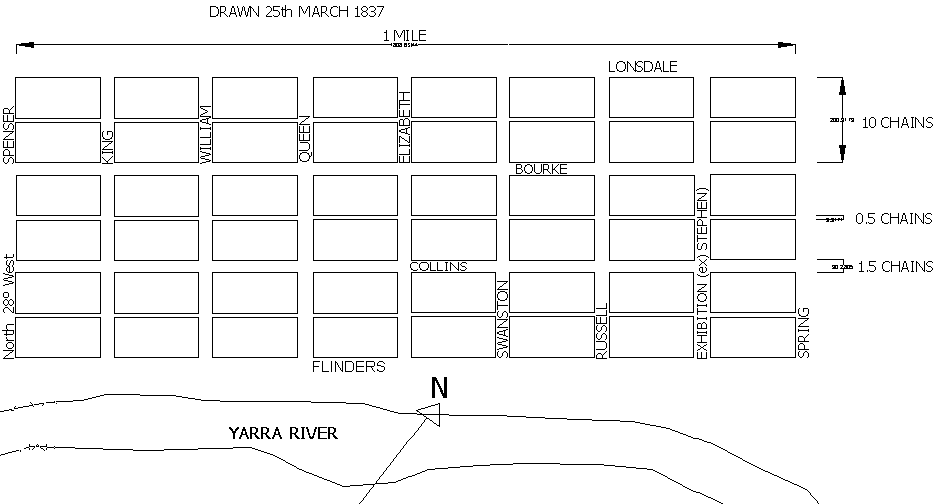The Hoddle Grid - Melbourne's Map
- astavovy
- Nov 4, 2023
- 4 min read
Updated: Jan 21
Welcome to the first post of Last Church Standing. LCS is primarily a personal interest blog about architecturally significant and interesting churches and places of worship in Melbourne, Victoria, and Australia. The idea of this blog stems from my countless photographic footsteps through Melbourne and observing these wonderful old buildings. Curiosity led me to research some of the history to discover interesting connections and fascinating stories about Melbourne becoming the place we see today.
The Hoddle Grid gives a context for the shape of Melbourne and for the origins of this idea. So before we launch into looking all those amazing churches it makes sense to have a quick look at the origins of the Hoddle grid and the place where Melbourne was born.

There is an abundance of historically significant churches and cathedrals in Melbourne. It is an attractive city made even more so by the many gothic-style churches spread throughout the city streets, particularly within the boundaries of the Hoddle Grid. The stories built into the stone of these buildings reflect the stories weaved into the layers of the city, and they offer a fascinating and rich historical observation of Melbourne's social, political and (to a lesser extent) religious diversity.
MELBOURNE was founded in 1835. It was incorporated as a Crown settlement in 1837 and officially declared a city by Queen Victoria of England in 1847. The Gold Rush of the 1850's & 1860's temporarily turned Melbourne into one of the world's largest and wealthiest cities and Melbourne served as the nations interim seat of government from Australia's federation in 1901 until 1927 when the Government moved to the new capital built in Canberra.
In 1837 at the behest of the Governor of NSW Richard Bourke, Government Surveyor Robert Hoddle laid out the plan for the city which was later to become known as the Hoddle Grid. The 'original' grid is a rectangular shape of large city blocks that covers the area from Flinders St to Queen Victoria Market and from Spencer St to Spring St.
"I staked the main streets ninety-nine feet wide, and after having done so was ordered by the Governor (Bourke) to make them sixty-six feet wide; but upon my urging, and convincing him that wide streets were advantageous on the score of health, and convenience to the future city of Victoria, he consented to let me have my will." Robert Hoddle.
At odds with Governor Bourke who wanted narrow main streets they managed a compromise by inserting narrow lanes running east/west between the main streets for rear access to blocks of land. Interestingly, every block has the same exact dimensions; forty-eight rectangular blocks, separated by wide boulevards and smaller streets. Back in the day Hoddle used a surveyors tool called Gunter's Chain to measure out the city streets. There's nothing complicated about the Hoddle Grid, no annoying winding rivers or body of waters, no hills, mountains or other geographic landforms to get in the way of a nice flat and simple evenly spaced grid. Each block squarely measures 10 chains 200m (660ft), major streets are 1.5 chains wide 30m/99ft, and between the major streets each narrow street measures 0.5 chains (10m/33ft). You can see the schematic plan below.
J Darnley at English Wikipedia, Public domain, via Wikimedia Commons
Within the Hoddle Grid stand nine significant heritage church buildings all built during the colonial Victorian Era (1837 - 1901) before the turn of the 19th century. Near the outskirts of the grid stand four more significant churches including St Patrick's Cathedral, Australia's largest cathedral and consecrated as a 'minor basilica' by the Vatican, and St Mary Star of the Sea, which I consider one of the most 'ornate' and outstanding of church interiors in Australia.

Prior to the Gold Rush the majority of Melbourne's buildings were made of timber, and apart from a very small number of other buildings, two of the first stone buildings still standing today, are churches, St James the Old Cathedral & St Francis. The GOLD RUSH was a catalyst for many of the prominent Victorian Era stone buildings in Melbourne today. Some of the buildings begun to be built during this period include Parliament House in 1855, State Library in 1856, the University of Melbourne in 1855, Treasury Building in 1858 and Trades Hall in 1859. These buildings and others, today still maintain an important visual and cultural presence in Melbourne.
You can find a wonderful online collection of early Melbourne photos presented by the Public Records Office Victoria and the Old Treasury Building museum here: https://tinyurl.com/muax9txx
All of these churches range in size from small churches tucked away and set back between large modern skyscrapers to the grand Cathedrals shaping the city skyline. They are significant not only for their mostly Gothic and Romantic architectural styles but also for the history they represent and weave through the collective city memory.
For the early pioneers of Melbourne, religion was a significant and inseparable part of the political, cultural and social fabric. That may not be the prevailing attitude but when you look closer at the architecture of these churches you very much see the story of Melbourne, its people and how it looks today.





















Comments